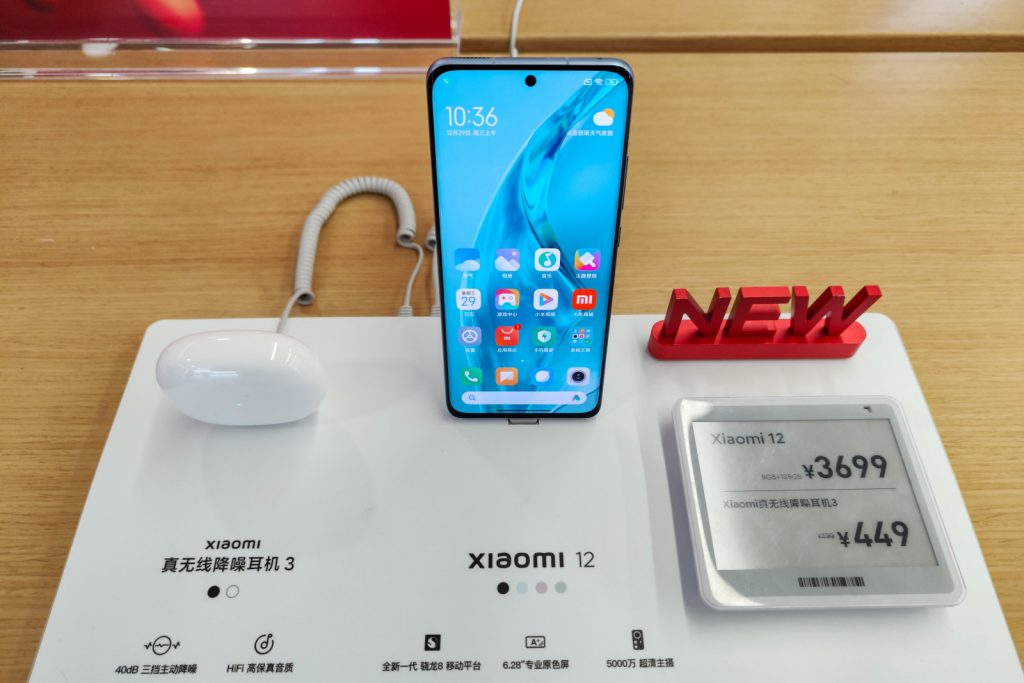(Wang Gang / Costfoto/Future Publishing via Getty Images)
The smartphone market feels saturated and lack of innovation is cited as the reason sales are falling. Global shipments peaked in 2016 at 1 473 million devices and since then it’s been on the decline.
The Covid-19 pandemic, a global chip shortage and subsequent rising costs have also affected consumer behaviour and spend, which means holding onto devices beyond the two-year upgrade cycle.
And, in a timely move, Xiaomi used Huawei’s disadvantage in the South African market by bringing in its flagship devices. Before Huawei lost access to Google Mobile Services and the Play Store, Xiaomi sold entry-level and mid-level smartphones here but that changed in October 2021 when it launched the 11T Pro.
This year though, it released the Xiaomi 12, and not the 12 Pro, which the Mail & Guardian had a chance to test for a week only. The inconsistency in model variants could be confusing to consumers, and feel as if Xiaomi is still testing the waters and things could change for better or worse.
Xiaomi South Africa tells the M&G it brings products to each market based on a “variety of internal and external factors” and aims to offer products that are “beneficial to fans and most suited to their lifestyles”.
The Xiaomi 12 is a 6.28-inch slim, elongated device that fits comfortably in your hand. It is lightweight at 180g and comes in purple, blue and grey.
 (Wang Gang/VCG via Getty Images)
(Wang Gang/VCG via Getty Images)
The handset is powered by a Snapdragon 8 Gen 1 chipset, 8GB of RAM and 256GB of storage which is not expandable. It has a 50MP triple rear camera and a 4500mAh battery that supports 67W fast charging. It has dual SIM support, Bluetooth 5.2, wi-fi 6, NFC and biometric security – facial and in-screen fingerprint unlocking.
The OLED display supports a 120Hz refresh rate that allows for smooth scrolling, animations and gaming, which is on par with current flagships from Samsung and iPhone. Though having it on 120Hz all the time does have an impact on the battery, which I toggled as I felt the need.
The screen looks great, as OLED screens do, with vivid colours, and is ideal for watching videos. The device has sound by Harmon Kardon and the dual speakers support Dolby Atmos, which makes a huge difference.
I used pic-in-pic mode on YouTube and Netflix to multitask while scrolling through social feeds and browsing. It worked smoothly; and it was like being able to do a second screening on one screen.
The fast processor is what made it possible. There was no lag between intensive apps. I went as far as opening all the apps preloaded on the device to have everything running simultaneously. I also uploaded photos to Google Drive and used the camera app.
Speaking of Google, Xiaomi has full access to Google Mobile Services, which includes the Play Store and the Google suite of apps. It comes preloaded onto the device, along with Xiaomi’s own software. The bloatware does eat into your non-expandable storage space.
The phone runs on Xiaomi’s MIUI 12 overlay on Android 12, which has improved over time. It offers a lot of customisation options if you’re into that. I liked the “always on” display with themes – or you could use a photo from the gallery.
The Xiaomi 12 has a triple rear camera set-up that comprises a 50MP wide-angle, 13MP ultra-wide and 5MP macro camera. It is missing a telephoto lens, so no optical zoom, but digital zoom in general isn’t great; objects tend to look blurry or grainy.
The camera does have AI features but I found the images too saturated with it turned on, and depending on time of day, HDR turned off. Night mode is excellent – just make sure the camera is steady – but the night video wasn’t as good.
The video camera shoots in 8K, and has motion and eye-tracking focus, which is great if you shoot a lot of videos. It also has a bunch of modes such as neon trails, light painting, star trails – like Huawei back in the day. The front camera is 32MP and shoots in 1080p.
The 4500mAh battery is more than capable and will last a full day. The 67W charger is great for a quick recharge if you’re pressed for time and it supports 50W wireless charging. The battery life is good overall but the way you use it will affect it. As mentioned earlier, I turned off 120Hz, but kept 5G turned on, and used it more for videos.
The Xiaomi 12 is a good Android flagship but not a great one. It has a compact design, powerful Snapdragon chip that handled whatever I threw at it, and is excellent for multimedia and multitasking, but it lacks key features found on rival counterparts. This includes an eSIM, IP68 rating for durability, telephoto lens and expandable storage.
Given that consumers are waiting longer between upgrade cycles, smartphones purchased in 2022 need to have features that last beyond the next two years. The Xiaomi 12 comes in at R18 000, which is a lot of money to part with if you consider the features it lacks. At that price point, don’t overlook the Samsung S22.